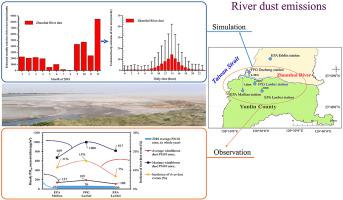Atmospheric Pollution Research ( IF 4.5 ) Pub Date : 2021-07-12 , DOI: 10.1016/j.apr.2021.101139 Tzu-Hsiang Weng , Yao-Chuan Lee , Wei-Hao Chen , Yu-Shiun Lin , Yuan-Chang Su , Yu-Huei Tong , Julius S. Chang , Ying I. Tsai

|
Taiwan's rivers dry during the winter, exposing large areas of river bed and leading to airborne aeolian river dust. This study used PM10 and windspeed data taken from monitoring stations local to the Zhuoshui River (the river with the largest exposed area in Taiwan) to investigate the relationship between airborne river dust and air quality, and subsequently to estimate river dust emissions. During river dust events, PM10 concentrations were significantly and positively correlated with wind speeds exceeding 5 m/s (the critical wind speed). FPG Lunbei station, located downwind (south of the river) and the closest station to the river, recorded an average hourly PM10 concentration of 189 ± 193 μg/m3 an average correlation coefficient (r) of 0.94 between hourly PM10 concentration and average hourly wind speed, an average annual dust occurrence rate of 15%, and a maximum PM10 concentration exceeding 1000 μg/m3. PM2.5 increased with PM10, albeit at a disproportional rate. When hourly PM10 concentration exceeded 200 μg/m3, most of the particulates in the dust were coarse particulates (PM2.5–10). An hourly PM2.5/PM10 ratio of <20% was used to determine whether air quality is affected by river dust. As the PM10 concentration increases, the PM2.5/PM10 ratio decreases. It was concluded that soil moisture and surface roughness must be added into the estimations for producing simulated data. With these added, simulated results were highly consistent with observed hourly PM10 concentrations, with a Pearson correlation coefficient of 0.82. The simulations of hourly PM10 concentration were highly accurate and indicated that river dust from the Zhuoshui River contributed to substantial increases in downwind PM10 concentrations. December was the worst single month, accounting for 28.0% of PM10 dust created by the Zhuoshui River in the entire year. Air quality was, however, severely reduced just south of the Zhuoshui River throughout the fall and winter.



























 京公网安备 11010802027423号
京公网安备 11010802027423号